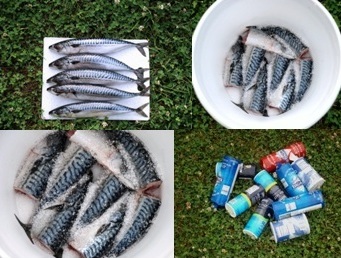
Prepping it was a lot of fun. I caused a run on Norwegian mackerel at the East Asian Market, with two other customers buying large amounts of the same species after I did. I also caused a bit of confusion in the staff when I told them not to clean the fish for me. They smiled and nodded and asked me three more times how I wanted it processed and I reassured them that I needed the fish whole, head and tail on, lightly rinsed. When I explained that I was going to make fish sauce, the manager stared at me for a moment and politely reminded me of the many varieties of fish and shrimp sauces and pastes they had in aisle seven.
My son helped me prepare the fish, which included only a good wash down and cutting them in two with the biggest knife he had ever held. He thought the fish were beautiful with their blue striped iridescent backs, and was only a little put off if a bit of blood flowed out of the gills during washing. He’s excellent at salting as well, and made sure there was a flat white layer of sea salt in between each layer of fish.
It was really quite simple to do and not all that messy, because the fish was very fresh. So far, there is absolutely no odor around the bucket, but that may change as the digestive enzymes start to break down the rest of the fish. Then stirring becomes important. We have a lot of wild animals in our area and I am interested to see what they make of this as time – and digestion – goes on.
One thing I found most interesting was that I used as much salt as I found necessary to completely cover the layers of fish along with a final layer that has got to be about an inch thick, and I didn’t even reach a 1:1 ratio of salt to fish. Now, most recipes of garum call for a 2:1 or even a 5:1 ratio of salt to fish. I just don’t see how this was necessary or even possible – we shall see. I never use as much salt as prescribed to make preserved lemons for North African and Andalusian cooking, and they always turn out just fine. Likewise, my Subcontinental vegetable and fruit pickles and my Kim Chee (and other Korean pickles) are also low on salt – and they turn out just fine as well. Much tastier than store bought, without the high sodium and citric acid to burn one’s mouth. Let’s hope my instinct to use less salt than recommended works with garum as well.
The plan is, first, to compare slow garum with a “fast” method utilizing a yogurt maker or crock pot. Then if we get good product, I’m going to make a whole variety of garums like the Romans would have used – oenogarum – garum mixed with different wines, another preparation mixing garum with must; oxygarum – garum mixed with vinegar and meligarum – garum mixed primarily with honey. I also hope to try several different herbal recipes used to flavor the garum for different foods. So, stay tuned – updates will be posted as add-ons to this post. (Words and photos of garum making by Laura Kelley; garum by Laura Kelley and son.)

How adventurous and exciting!
Are you sure about the quantity of salt? Geoponica and various other recipes recommend about one part salt for every eight parts fish.
I just started my first batch today (3.5 kg of mackerel with 500 grams of salt to be on the safe side). Should I add more salt?
Your mackerel will probably rot before they digest with that small amount of salt. I used a reverse ratio (more salt than fish) and it worked well. Stir it well every couple of days. If you’ve made one of the “cooked” garum recipes. That’s not garum. There is a tremendous amount of misinformation about garum on the web – for instance, that its Greek – NOT. Unless you got the information direct from Geoponic on Penelope or some other site, I wouldn’t trust it